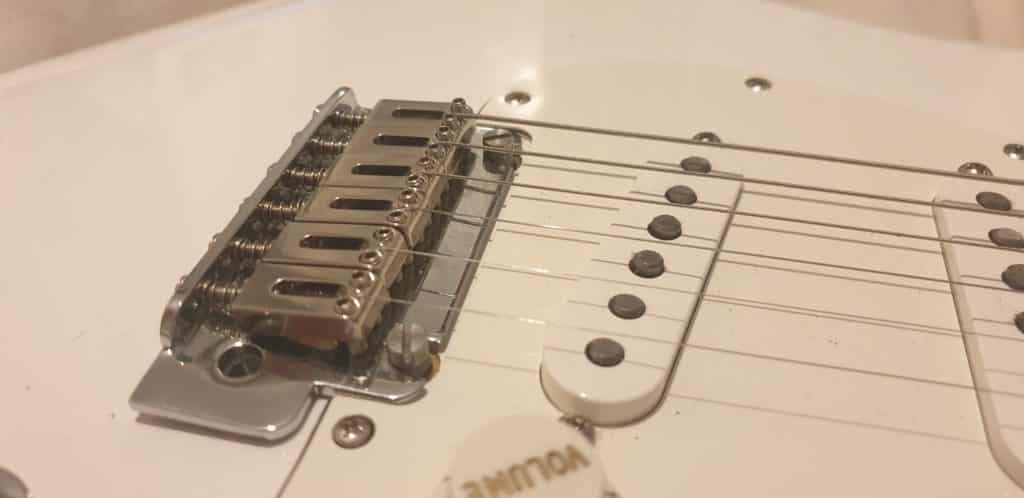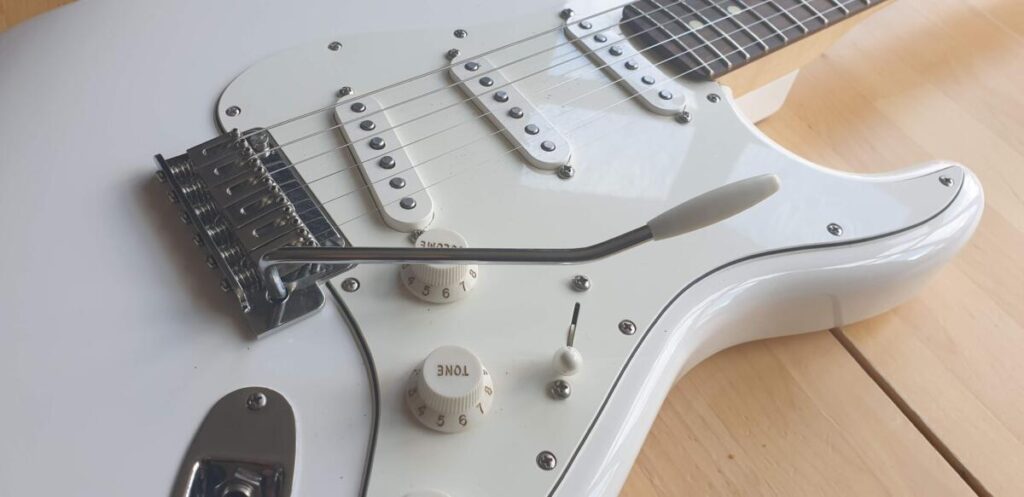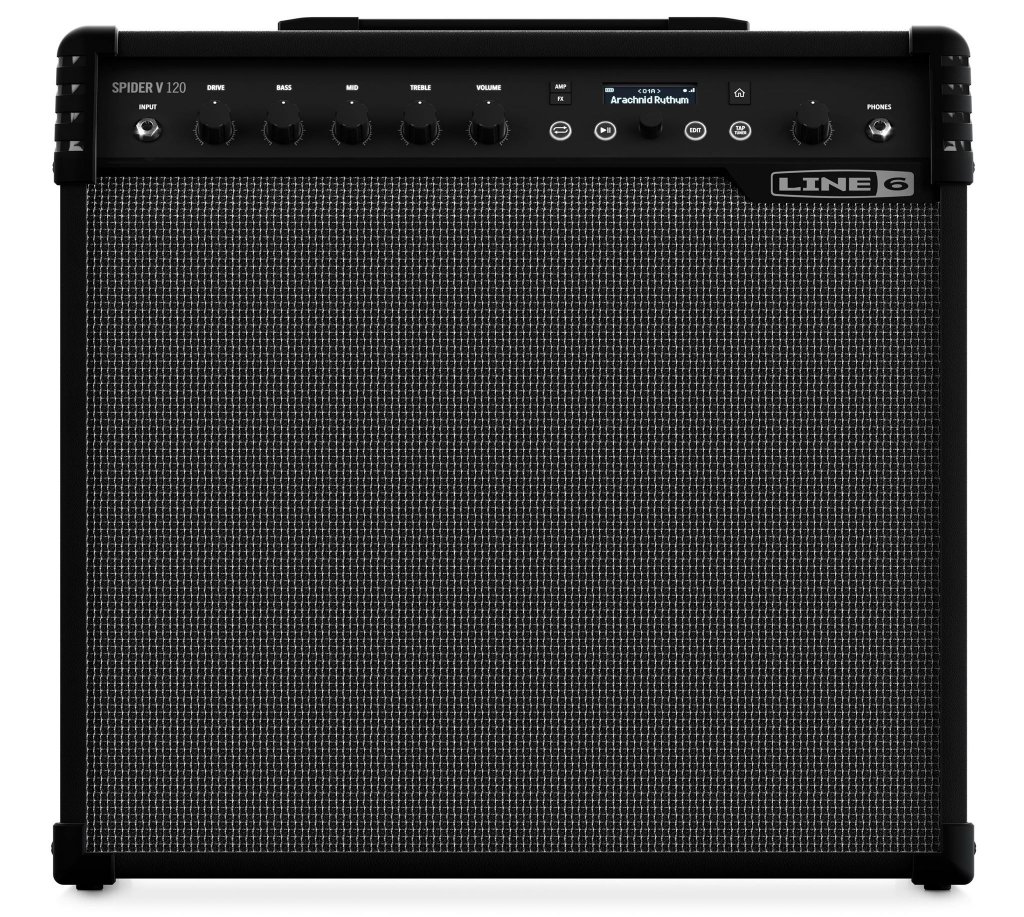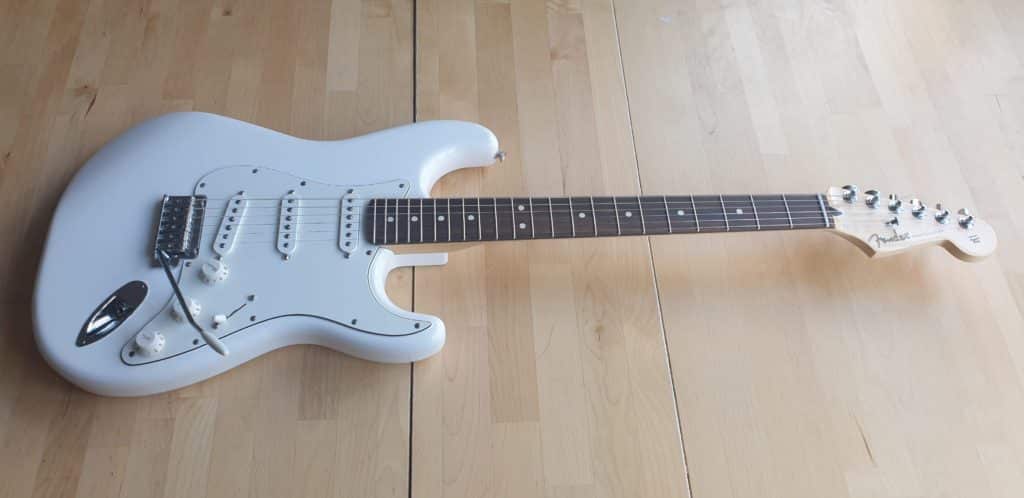5 Cheap Fender Stratocaster upgrades that are quick, easy, and effective.
Lighter string gauge/locking string wrap – £5.
The simplest and most effective way to improve your guitar’s playability is to move down a string gauge. Most Stratocaters leave the factory with 9 gauge strings, so I would recommend switching to 8’s. Ernie Ball 8’s in fact. They’re individually wrapped so they don’t tie you up in knots!
Of course, many will say moving down a gauge means inferior tone, tuning stability, and string life, but I’ve countered one of those arguments (stability) by using the tech string wrapping method which binds the string between wraps, locking it in place.
I can report this works flawlessly in keeping your Stratocaster in tune, even under severe whammy abuse, and with 8’s.
As for the other arguments of tone and string life? All I can say is try 8’s and I think you’ll be too engrossed in the improved playing experience to care, with the differences being negligible, if not unnoticeable anyway.
Although not really necessary for non-trem guitars like Gibson Les Pauls, it’s still worth a try.
I’ve tried the other locking factory method, where the string is locked to the post rather than between strings. This is more fiddly and ultimately easier to mess up, with the result being poor stability. In contrast, the tech method is easy and effective.
Forget about purchasing locking tuners. They will save you a few seconds on string changes. nothing more.
Block Saddles – £10 (full set)
I’ve covered this in another blog. Upgrading from the original bent-steel saddles is a no-brainer for me on all counts.
I purchased mine from Northwest Guitars. Love them.

Trem springs – £8 (pack of 12)
Notice how USA Strats on the shop wall have a round sticker covering the trem-arm hole? That’s to stop the trem spring from falling out. Anything less than the USA models (Including my Fender Player Strat) won’t come supplied with a trem spring but they’re vital to operation for screw-in type trems.
Why? Because screw-in arms often have an annoying looseness/play in them that feels clunky and disconnected. Yes, you can tighten the arm with more turns but then it becomes too stiff and unmanageable.
Solution? Drop a trem spring into the hole, then screw in the arm for a perfectly tensioned, and much more pleasing/natural to use bar which feels properly connected. Other, cheaper solutions have been mooted, including various PTFE/Teflon tape over the threads, but in my experience, that’s not very effective or permanent.
Trem spring all the way then, just be careful about losing them (buy spares).
0000 Steel Wool/Lemon Oil. (£2 + £4)
For rosewood fingerboards only.
Keeping your fingerboard and frets in tip-top condition has a massive impact on your playing experience, not to mention tone. There’s often been a time when I’ve had buzzing issues, scratchy bends, and generally a feeling of something not being right with the guitar.
What you should always do, before tinkering with setup, is make sure your frets and fingerboard are properly cleaned, conditioned, and polished. This is something a lot of us forget/don’t bother to do and can transform a poorly playing instrument.
I bought a bottle of Dunlop Formula 65 Ultimate Lemon Oil about 20 years ago and It’s still going strong. It’s the only product you’ll ever need for rosewood fingerboard conditioning. After a quick application, it’ll look and feel like new again.
0000 Steel wool is even cheaper and super quick and effective at cleaning the fingerboard and cleaning/polishing the frets in one pass.
For maple fingerboards, you’ll also need to tape up the fingerboard while polishing the frets, but in either case, the pickups must be covered (with masking tape in my case) so that the filings from the steel wool don’t wreck your pickups.
Wreck your pickups?!
There’s a risk to anything in life, and many have now gone down the micromesh/fret eraser route which is far more expensive and needs far more passes. grades to achieve a similar result. The non-P number grading system is also a minefield. Personally, if I was a luthier or tech working on lots of guitars on a daily basis, the problem with filings would be more severe. But two-three times a year? I’ll take the necessary precautions and save on the extra work (and expense) of the other, less effective (but admittedly cleaner and less risky) methods.
Just be careful and remember to tape up your pickups, or even better, mop all the filings up with a fridge magnet, or even better still, tape, a fridge magnet, and another layer of tape over the filings when you’re done.
0000 Steel wool is the traditional tool for the job. Use it, save yourself the hassle, and save the money. It’s readily available online or from hardware stores.
String tree – £10
Whatever string tree upgrade you go for, lose those butterfly-style types that have far too much contact with strings and will cause you no end of tuning issues.
I went for the old American Standard-style with the two small pins protruding from each side, minimising the string contact area/friction. I love the look of these, but you could also go for any number of roller tree options that would be equally if not more effective.
Total Cost: £39!
I thought my Player Strat was pretty close to an American Pro II Strat, to begin with, but that was before a massive upgrade with very little outlay using a number of items I already had and/or will last a lifetime.
A different spring wrap, with lighter strings over a cleaner and polished board with a properly tensioned trem feels like a huge leap in performance. It’s slinky and fast, but at the same time stable, with a quality, expensive feel…
.. and all from a few bits and pieces lying about and amazon delivery!
How do you cheaply upgrade your Strat? Drop me a comment below.



